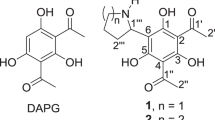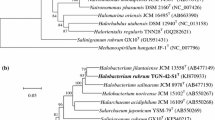Abstract
L-Ornithine is the only diamino acid of the peptidoglycan of the gliding phototrophic Chloroflexus aurantiacus. The other constituents are L- and D-alanine, D-glutamic acid, N-acetyl-glucosamine and N-acetyl-muramic acid (in part as muramic acid-6-phosphate), all in approximate equimolar ratios to L-ornithine, aside from small amounts of glycine and histidine. Furthermore unlike typical Gram-negative bacteria, protein is not bound to this peptidoglycan. Instead, the rigid layer (sodium dodecyl sulfate insoluble cell wall fraction) contained large amounts of a complex polysaccharide consisting of sugar O-methyl ethers, hexoses and pentoses. Its binding site is presumably muramic acid-6-phosphate of the peptidoglycan.
In contrast, in Chlorobium vibrioforme f. thiosulfatophilium, meso-diaminopimelic acid was found as the only diamino acid of this peptidoglycan. As with other Gramnegative bacteria, L- and D-alanine, D-glutamic acid, N-acetyl-glucosamine and N-acetyl-muramic acid (no muramic acid-6-phosphate) were observed in approximate equimolar ratios to meso-diaminopimelic acid, except a lower D-alanine content. The rigid layer of Chlorobium vibrioforme f. thiosulfatophilum contained protein, and there were no indications for a complex polysaccharide comparable to that of Chloroflexus aurantiacus.
Similar content being viewed by others
Abbreviations
- Ala:
-
alanine
- A2pm:
-
diaminopimelic acid
- GC/MS:
-
combined gas-liquid chromatography/mass spectrometry
- GlcNAc:
-
N-acetyl-glucosamine
- Glu:
-
glutamic acid
- Gly:
-
glycine
- HF:
-
hydrofluoric acid
- Lys:
-
lysine
- MurNAc:
-
N-acetyl-muramic acid
- Orn:
-
ornithine
- SDS:
-
sodium dodecyl sulfate
References
Araki Y, Nakatani T, Nakayama K, Ito E (1972) Occurrence of N-nonsubstituted glucosamine residues in peptidoglycan of lysozyme-resistant cell walls from Bacillus cereus. J Biol Chem 247:6312–6322
Azuma I, Taniyama T, Yamamura Y, Yanagihara Y, Hattori Y, Yasuda S, Mifuchi I (1975) Chemical studies on the cell walls of Leptospira biflexa strain Urawa and Treponema pallidum strain Reiter. Japan J Microbiol 19:45–51
Beyer P, Falk H, Kleinig H (1983) Particulate fractions from Chloroflexus aurantiacus and distribution of lipids and polyprenoid forming activities. Arch Microbiol 134:60–63
Braun V, Rehn K (1969) Chemical characterization, spatial distribution and function of lipoprotein of the Escherichia coli cell wall. Eur J Biochem 10:426–438
Castenholz RW (1969) Thermophilic blue-green algae and the thermal environment. Bacteriol Rev 33:476–504
Cohen-Bazire G, Pfennig N, Kunisawa R (1964) The fine structure of green bacteria. J Cell Biol 22:207–225
Drews G, Weckesser J, Mayer H (1978) Cell envelopes. In: Clayton RK, Sistrom WR (eds). The photosynthetic bacteria. Plenum Press, New York, USA, pp 61–77
Evers D, Weckesser J, Jürgens UJ (1986) Chemical analyses on cell envelope polymers of the halophilic, phototrophic Rhodospirillum salexigens. Arch Microbiol 145:254–258
Feick R, Fuller RC (1984) Topography of the photosynthetic apparatus of Chloroflexus aurantiacus. Biochemistry 23:3693–3700
Fox GE, Stackebrandt E, Hesbell RB, Gibson J, Maniloff J, Dyer TA, Wolfe RS, Balch WE, Tanner RS, Magrum LJ, Zablen LB, Blakemore R, Gupta R, Bonen L, Lewis BJ, Stahl DA, Luehrsen KR, Chen KN, Woese CR (1980) The phylogeny of prokaryotes. Science 209:457–463
Gibson J, Pfennig N, Waterbury JB (1984) Chloroherpeton thalassium gen. nov. et spec. nov., a non filamentous, flexing and gliding green sulfur bacterium. Arch Microbiol 138:96–101
Gibson J, Ludwig W, Stackebrandt E, Woese CR (1985) The phylogeny of the green photosynthetic bacteria: absence of a close relationship between Chlorobium and Chloroflexus. System Appl Microbiol 6:152–156
Hayashi K (1975) A rapid determination of sodium dedecyl sulfate with methyleneblue. Anal Biochem 67:503–506
Hensel R, Demharter W, Kandler O, Kropenstedt RM, Stackebrandt E (1986) Chemotaxonomic and molecular-genetic studies of the genus Thermus: evidence for a phylogenetical relationship of Thermus aquaticus and Thermus ruber to the genus Deinococcus. Int J Syst Bacteriol 36:444–453
Jürgens UJ, Weckesser J (1986) Polysaccharide covalently linked to the peptidoglycan of the cyanobacterium Synechocystis sp. strain PCC6714. J Bacteriol 168:568–573
Jürgens UJ, Drews G, Weckesser J (1983) Primary structure of the peptidoglycan from the unicellular cyanobacterium Synechocystis sp. strain PCC 6714. J Bacteriol 154:471–478
Knudson E, Jantzen E, Bryn K, Ormerod JG, Sirevag R (1982) Quantitative and structural characteristics of lipids in Chlorobium and Chloroflexus. Arch Microbiol 132:149–154
König WA, Benecke I, Bretting H (1981) Gaschromatographische Trennung enantiomerer Kohlenhydrate an einer neuen chiralen stationären Phase. Angew Chem 93:688–690
Lowry OH, Roberts NR, Leiner KY, Wu ML, Farr AL (1954) The quantitative histochemistry of brain. J Biol Chem 207:1–17
Mayer H, Weckesser J (1984) ‘Unusual’ lipid A's: structures, taxonomical relevance and potential value for endotoxin research. In: Rietschel ETH (ed) Handbook of endotoxin, vol 1, Chemistry of endotoxin. Elsevier, Amsterdam, pp 221–247
Merkel GJ, Stapleton, SS, Perry JJ (1978) Isolation and peptidoglycan of Gram-negative hydrocarbon-utilizing thermophilic bacteria. J Gen Microbiol 109:141–148
Ota T (1980) Purification and chemical analysis of peptidoglycan from Treponema pallidum strain Kazan. J Osaka Odontol Soc 43:589–602
Pask-Hughes RA, Shaw N (1982) Glycolipids from some extreme thermophilic bacteria belonging to the genus Thermus. J Bacteriol 149:54–58
Pask-Hughes RA, Williams RAD (1978) Cell envelope components of strains belonging to the genus Thermus. J Gen Microbiol 107:65–72
Pierson BK, Castenholz RW (1974) A phototrophic gliding filamentous bacterium of hot springs, Chloroflexus aurantiacus, gen. and sp. nov. Arch Microbiol 100:5–24
Schleifer KH, Joseph R (1973) A directly cross-linked L-ornithine containing peptidoglycan in cell walls of Spirochaeta stenostrepta. FEBS Lett 36:83–86
Schleifer KH, Kandler O (1972) Peptidoglycan types of bacterial cell walls and their taxonomical implications. Bacteriol Rev 36:407–477
Schleifer KH, Kandler O (1983) Primary structures of murein and pseudomurein. In: Hakenbeck R, Höltje JV, Labischinski H (eds) The target of penicillin. Gruyter, Berlin New York, pp 11–17
Staehelin LA, Golecki JR, Fuller RC, Drews G (1978) Visualization of the supramolecular architecture of chlorosomes (chlorobium type vesicles) in freeze-fractured cells of Chloroflexus aurantiacus. Arch Mikrobiol 119:269–277
Staehelin LA, Golecki JR, Drews G (1980) Supramolecular organization of chlorosomes (Chlorobium vesicles) and of their membrane attachment sites in Chlorobium limicola. Biochim Biophys Acta 589:30–45
Steinmetz MA, Fischer U (1982) Cytochromes of the green sulfur bacterium Chlorobium vibrioforme f. thiosulfatophilum. Purification, characterization and sulfur metabolism. Arch Microbiol 131:19–26
Umemoto T, Ota T, Sagawa H, Kato K, Takada H, Tsujimoto M, Kawasaki A, Ogawa T, Harada K, Kotani S (1981) Chemical and biological properties of a peptidglycan isolated from Treponema pallidum Kazan. Infect Immun 31:767–774
Vasstrand EN, Hofstad T, Endresen C, Jensen HB (1979) Demonstration of lanthionine as a natural constituent of the peptidoglycan of Fusobacterium nucleatum Fevl. Infect Immun 25:775–780
Work E (1964) Amino acids of walls of Micrococcus radiodurans. Nature (Lond) 201:1107–1109
Yanagihara Y, Kamisango K, Yasuda S, Kobayashi S, Mifuchi I, Azuma I, Yamamura Y, Johnson RC (1984) Chemical composition of cell walls and polysaccharide fractions of spirochetes. Microbiol Immunol 28:535–544
Author information
Authors and Affiliations
Rights and permissions
About this article
Cite this article
Jürgens, U.J., Meißner, J., Fischer, U. et al. Orinithine as a constituent of the peptidoglycan of Chloroflexus aurantiacus, diaminopimelic acid in that of Chlorobium vibrioforme f. thiosulfatophilum . Arch. Microbiol. 148, 72–76 (1987). https://doi.org/10.1007/BF00429651
Received:
Accepted:
Issue Date:
DOI: https://doi.org/10.1007/BF00429651




